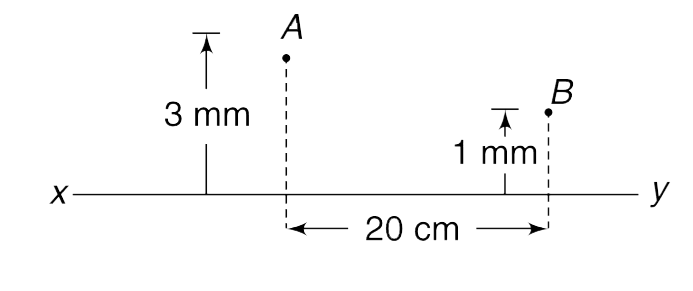An image I is formed of point object O by a lens whose optic axis is AB as shown in figure.

(a) State whether it is a convex lens or concave?
(b) Draw a ray diagram to locate the lens and its focus.
(i) Concave lens always forms an erect image. The given image I is on the other
side of the optic axis. Hence, the lens is convex.
(ii) Join O with I. Line OI cuts the optic axis AB at optical centre (P) of the lens. The dotted line
shows the position of lens.

From point O, draw a line parallel to AB. Let it cut the dotted line at M. Join M with I. Line
MI cuts the optic axis at focus (F) of the lens.
Topper's Solved these Questions
- REFRACTION OF LIGHTBOOK - DC PANDEYCHAPTER - REFRACTION OF LIGHTEXERCISE - Example Type 10
1 Videos
- REFRACTION OF LIGHTBOOK - DC PANDEYCHAPTER - REFRACTION OF LIGHTEXERCISE - Example Type 11
3 Videos
- REFLECTION OF LIGHTBOOK - DC PANDEYCHAPTER - REFLECTION OF LIGHTEXERCISE - Subjective
9 Videos
- SEMICONDUCTORSBOOK - DC PANDEYCHAPTER - SEMICONDUCTORSEXERCISE - Subjective
12 Videos
Similar Questions
An image I is formed of a point object O by a mirror whose principal axis is AB as shown in figure.

(a) State whether it is a convex mirror or a concave mirror .
(b)Draw a ray diagram to locate the mirror and its focus . Write down the step of construction of the ray diagram. Consider the possible two cases.
(1) When distance of I from AB is more than the distance of O from AB and
(2) When distance of O from AB is more than the distance of I from AB
View SolutionAn image I is formed of a point object O by a mirror whose principal axis is AB as shown in figure.

(a) State whether it is a convex mirror or a concave mirror .
(b)Draw a ray diagra to laacate the mirror and its focus . Write down the step of construction of the ray diagram. Consider the possible two cases.
(1) When distance of I from AB is more than the distance of O from AB and
(2) When distance of O from AB is more than the distance of I from AB
View SolutionAn image Y is formed of a point object x by a lens whose optic axis is AB as shown in Figure. Draw a ray diagram to locate the lens and its focus. If the image Y of object X is formed by a concave mirror (having the same optic axis AB) instead of lens, draw another ray diagram to locate the mirror and its focus. Write down the steps of construction of the ray diagrams.

View SolutionAn image Y is formed of a point object x by a lens whose optic axis is AB as shown in Figure. Draw a ray diagram to locate the lens and its focus. If the image Y of object X is formed by a concave mirror (having the same optic axis AB) instead of lens, draw another ray diagram to locate the mirror and its focus. Write down the steps of construction of the ray diagrams.

View SolutionAn image B is formed of a real point object A by a lens whose optic axis is XY.
(a) Draw a ray diagram to locate the lens and its focus point.
(b) If A and B are separated by 20 cm along the axis, find the focal length of the lens.

View SolutionState the rules to draw a ray diagram of a convex lens with proper figures.
View SolutionAB is the optic axis of a lens. Lens is not shown in the figure. O and I are the position of object and image. Then match of following.

View SolutionAB is the optic axis of a lens. Lens is not shown in the figure. O and I are the position of object and image. Then match of following.

View SolutionA linear object is placed on the axis of a lens. An image is formed by refraction in the lens. For all positions of the object on the axis of the lens, the positions of the image are always between the lens and the object.
(i) Name the lens.
(ii) Draw a ray diagram to show the formation of the image of an object placed in front of the lens at any position of your choice except infinity.
View SolutionA lens forms an upright and diminished image of an object when the object is placed at the focal point of the given lens.
Draw a ray diagram to show the image formation.
View Solution
